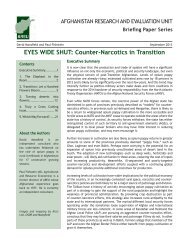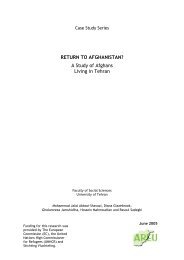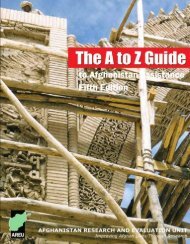Local Governance in Afghanistan: A View from the Ground
Local Governance in Afghanistan: A View from the Ground
Local Governance in Afghanistan: A View from the Ground
- No tags were found...
You also want an ePaper? Increase the reach of your titles
YUMPU automatically turns print PDFs into web optimized ePapers that Google loves.
<strong>Afghanistan</strong> Research and Evaluation Unit<br />
2011<br />
Asian Development Bank, UNDP, <strong>the</strong> UN Office on Drugs and Crime and <strong>the</strong> World Bank) <strong>in</strong> seek<strong>in</strong>g to<br />
better def<strong>in</strong>e corruption <strong>in</strong> <strong>the</strong> Afghan context. 138 However, <strong>the</strong>re rema<strong>in</strong>s a need to complement this<br />
understand<strong>in</strong>g with a degree of realism over how far <strong>the</strong> country can hope to reduce corruption <strong>in</strong> <strong>the</strong><br />
foreseeable future. As has been widely acknowledged, gaps exist between <strong>in</strong>ternational standards 139<br />
and <strong>the</strong> <strong>in</strong>stitutional realities of <strong>Afghanistan</strong>. So large are <strong>the</strong>se gaps that it would be naive to<br />
expect <strong>the</strong> complete elim<strong>in</strong>ation of corruption. However, <strong>the</strong> devolution of plann<strong>in</strong>g and budget<strong>in</strong>g<br />
presents a realistic opportunity of manag<strong>in</strong>g corruption and promot<strong>in</strong>g accountable governance. This<br />
would reduce <strong>the</strong> <strong>in</strong>formation asymmetries between <strong>the</strong> central and local government and promote<br />
transparency.<br />
Despite <strong>the</strong> reforms that have been undertaken, <strong>the</strong>re rema<strong>in</strong> doubts about how enthusiastically<br />
<strong>the</strong> Afghan government is pursu<strong>in</strong>g its anti-corruption agenda. It has established an <strong>in</strong>dependent<br />
High Office of Oversight and Anti-Corruption (HOO) to oversee a strategy focus<strong>in</strong>g on awareness,<br />
prevention, detection and prosecution of corruption. 140 To produce an impact, this strategy will need<br />
to be <strong>in</strong>tegrated <strong>in</strong>to adm<strong>in</strong>istrative reforms and <strong>the</strong> operation of justice <strong>in</strong>stitutions. It will require<br />
a renewed emphasis on shar<strong>in</strong>g <strong>in</strong>formation and <strong>the</strong> <strong>in</strong>creased engagement of l<strong>in</strong>e departments with<br />
<strong>the</strong> communities to which <strong>the</strong>y deliver services.<br />
Policy Issues: S<strong>in</strong>ce <strong>the</strong> HOO relies on <strong>the</strong> president’s office for budgets and <strong>the</strong> power of sanction,<br />
efforts must be made to ensure <strong>the</strong> body ma<strong>in</strong>ta<strong>in</strong>s its <strong>in</strong>dependence. 141 Ombudsmen or Public<br />
Information Officers represent<strong>in</strong>g HOO need to be appo<strong>in</strong>ted with<strong>in</strong> all prov<strong>in</strong>cial adm<strong>in</strong>istrations.<br />
To ensure checks and balances and that all powers of <strong>in</strong>vestigation and prosecution are not solely<br />
vested <strong>in</strong> <strong>the</strong> HOO, prov<strong>in</strong>cial and district councils should also be given rights to hold prov<strong>in</strong>cial and<br />
district adm<strong>in</strong>istrations accountable. A third layer of scrut<strong>in</strong>y should be created by cont<strong>in</strong>u<strong>in</strong>g to<br />
encourage <strong>the</strong> <strong>in</strong>volvement of non-state actors via mandatory social audits. Such measures could lay<br />
<strong>the</strong> foundation for giv<strong>in</strong>g citizens <strong>the</strong> right to <strong>in</strong>formation. 142 In terms of justice delivery, <strong>the</strong>re should<br />
be a clear separation of powers between <strong>the</strong> adm<strong>in</strong>istration, representative bodies and <strong>the</strong> judiciary.<br />
To conta<strong>in</strong> and constra<strong>in</strong> abuses of power, <strong>the</strong>re is a need to establish how powers of oversight<br />
between <strong>the</strong>se branches can be made more effective.<br />
7.9 Donors<br />
Coord<strong>in</strong>ation between donors and <strong>the</strong> Afghan government has been historically difficult to achieve.<br />
The 2010 London Conference on <strong>Afghanistan</strong> identified <strong>the</strong> need to channel development assistance<br />
more effectively through <strong>the</strong> government, supported by <strong>the</strong> reform of government structures and<br />
budget<strong>in</strong>g mechanisms. The conference also highlighted concerns over <strong>the</strong> need to better align<br />
donor efforts with government strategies, and acknowledged that <strong>the</strong> provision and spend<strong>in</strong>g of<br />
development assistance <strong>in</strong> <strong>Afghanistan</strong> needed to be more transparent and accountable.<br />
While it was hoped that some of <strong>the</strong>se issues could be dealt with through adm<strong>in</strong>istrative reforms,<br />
donor-driven agendas to date have contributed to <strong>the</strong> duplication of local government structures <strong>in</strong><br />
<strong>Afghanistan</strong>. The fragmentation result<strong>in</strong>g <strong>from</strong> this duplication has been significant. The high number<br />
of donors, <strong>the</strong> differences between <strong>the</strong>ir f<strong>in</strong>ancial systems and policy and programme priorities,<br />
and <strong>the</strong> variety of delivery mechanisms pose a major challenge for state <strong>in</strong>stitutions. In <strong>the</strong> local<br />
government sector, poor donor coord<strong>in</strong>ation has resulted <strong>in</strong> <strong>the</strong> fund<strong>in</strong>g of compet<strong>in</strong>g programmes<br />
operat<strong>in</strong>g to different timetables. A prime example has been <strong>the</strong> formation of District Development<br />
Assemblies under NABDP and District Community Councils under ASOP (Section 5.5, Section 6.2,<br />
Section 7.2). In prov<strong>in</strong>ces where <strong>the</strong>y co-exist, DDAs and DCCs’ responsibilities have overlapped. As<br />
has been noted, this has not only created confusion among <strong>the</strong>ir constituencies but also <strong>in</strong>hibited<br />
138 “Draft Anti-Corruption Roadmap for <strong>the</strong> Islamic Republic of <strong>Afghanistan</strong>” (2007).<br />
139 As described by <strong>the</strong> UN Convention Aga<strong>in</strong>st Corruption.<br />
140 “Draft Anti-Corruption Roadmap for <strong>the</strong> Islamic Republic of <strong>Afghanistan</strong>,” 13.<br />
141 Law on <strong>the</strong> Supervision and Implementation of Anti-corruption Strategies (Official Gazette no. 957), 2009 (SY 1387).<br />
142 Under <strong>the</strong> right to <strong>in</strong>formation, a citizen may be able to request <strong>in</strong>formation <strong>from</strong> any government <strong>in</strong>stitution.<br />
<strong>Local</strong> <strong>Governance</strong> <strong>in</strong> <strong>Afghanistan</strong>: A <strong>View</strong> <strong>from</strong> <strong>the</strong> <strong>Ground</strong><br />
63

















